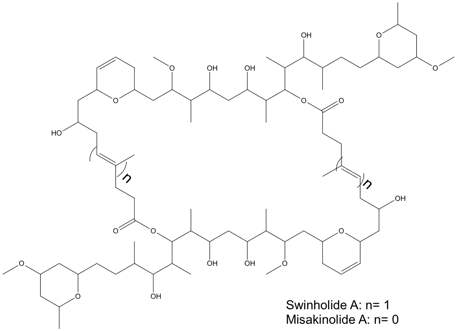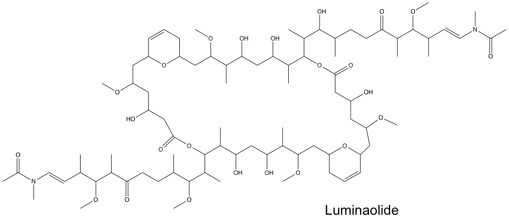|
Swinholide
Swinholides are Protein dimer, dimeric 42 carbon-ring Polyketide, polyketides that exhibit a 2-fold axis of symmetry. Found mostly in the marine sponge Theonella, swinholides encompass cytotoxic and antifungal activities via disruption of the actin skeleton. Swinholides were first described in 1985 and the structure and stereochemistry were updated in 1989 and 1990, respectively. Thirteen swinholides have been described in the literature, including close structural compounds such as misakinolides/bistheonellides, ankaraholides, and hurgholide A It is suspected that symbiotic microbes that inhabit the sponges rather than the sponges themselves produce swinholides since the highest concentration of swinholides are found in the unicellular bacterial fraction of sponges and not in the sponge fraction or cyanobacteria fraction that also inhabit the sponges. From a marine field sample containing the cyanobacterium ''Symploca'' sp, Swinholide A has also been reported in literature. The s ... [...More Info...] [...Related Items...] OR: [Wikipedia] [Google] [Baidu] |
Swinholide Biosynthesis
Swinholides are Protein dimer, dimeric 42 carbon-ring Polyketide, polyketides that exhibit a 2-fold axis of symmetry. Found mostly in the marine sponge Theonella, swinholides encompass cytotoxic and antifungal activities via disruption of the actin skeleton. Swinholides were first described in 1985 and the structure and stereochemistry were updated in 1989 and 1990, respectively. Thirteen swinholides have been described in the literature, including close structural compounds such as misakinolides/bistheonellides, ankaraholides, and hurgholide A It is suspected that symbiotic microbes that inhabit the sponges rather than the sponges themselves produce swinholides since the highest concentration of swinholides are found in the unicellular bacterial fraction of sponges and not in the sponge fraction or cyanobacteria fraction that also inhabit the sponges. From a marine field sample containing the cyanobacterium ''Symploca'' sp, Swinholide A has also been reported in literature. The s ... [...More Info...] [...Related Items...] OR: [Wikipedia] [Google] [Baidu] |

